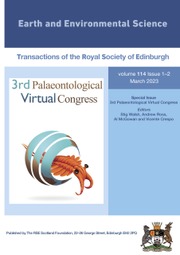Crossref Citations
This article has been cited by the following publications. This list is generated based on data provided by
Crossref.
HARRIS, JOHN E.
1951.
Diademodus hydei, a new fossil shark from the Cleveland Shale..
Proceedings of the Zoological Society of London,
Vol. 120,
Issue. 4,
p.
683.
Groß, Walter
1954.
Zur Phylogenie des Schultergürtels.
Paläontologische Zeitschrift,
Vol. 28,
Issue. 1-2,
p.
20.
Westoll, T. S.
1961.
Recent advances in the palæontology of fishes.
Geological Journal,
Vol. 2,
Issue. 3,
p.
568.
Miles, R. S.
1962.
III.—Gemuendenaspisn.gen., an Arthrodiran Fish from the Lower Devonian Hunsrückschiefer of Germany.
Transactions of the Royal Society of Edinburgh,
Vol. 65,
Issue. 3,
p.
59.
Gross, Walter
1962.
Neuuntersuchung der Dolichothoraci aus dem Unterdevon von Overath bei Köln.
Paläontologische Zeitschrift,
Vol. 36,
Issue. S1,
p.
45.
WESTOLL, T. S.
1962.
Ptyctodontid Fishes and the Ancestry of Holocephali.
Nature,
Vol. 194,
Issue. 4832,
p.
949.
Miles, R. S.
and
Westoll, T. S.
1962.
IX.—Two New Genera of Coccosteid Arthrodira from the Middle Old Red Sandstone of Scotland, and their Stratigraphical Distribution.
Transactions of the Royal Society of Edinburgh,
Vol. 65,
Issue. 9,
p.
179.
Miles, Roger S.
1966.
XV.—The Placoderm Fish Rhachiosteus pterygiatus Gross and its Relationships.
Earth and Environmental Science Transactions of the Royal Society of Edinburgh,
Vol. 66,
Issue. 15,
p.
377.
Miles, Roger S.
1967.
Observations on the ptyctodont fish, Rhamphodopsis Watson.
Journal of the Linnean Society of London, Zoology,
Vol. 47,
Issue. 311,
p.
99.
Miles, Roger S.
and
Westoll, T. Stanley
1968.
IX.—The Placoderm FishCoccosteus cuspidatusMiller ex Agassiz from the Middle Old Red Sandstone of Scotland. Part I. Descriptive Morphology.
Transactions of the Royal Society of Edinburgh,
Vol. 67,
Issue. 9,
p.
373.
Miles, Roger S.
1969.
VI.—Features of Placoderm Diversification and the Evolution of the Arthrodire Feeding Mechanism..
Transactions of the Royal Society of Edinburgh,
Vol. 68,
Issue. 6,
p.
123.
Moy-Thomas, J. A.
1971.
Palaeozoic Fishes.
p.
61.
Moy-Thomas, J. A.
1971.
Palaeozoic Fishes.
p.
161.
Starck, Dietrich
1979.
Vergleichende Anatomie der Wirbeltiere auf evolutionsbiologischer Grundlage.
p.
463.
FOREY, PETER L.
and
GARDINER, BRIAN G.
1986.
Observations on Ctenurella (Ptyctodontida) and the classification of placoderm fishes.
Zoological Journal of the Linnean Society,
Vol. 86,
Issue. 1,
p.
43.
YOUNG, G. C.
1986.
The relationships of placoderm fishes.
Zoological Journal of the Linnean Society,
Vol. 88,
Issue. 1,
p.
1.
Larouche, Olivier
Zelditch, Miriam L.
and
Cloutier, Richard
2019.
A critical appraisal of appendage disparity and homology in fishes.
Fish and Fisheries,
Vol. 20,
Issue. 6,
p.
1138.
Enny, Alyssa
Flaherty, Kathleen
Mori, Shunsuke
Turner, Natalie
and
Nakamura, Tetsuya
2020.
Developmental constraints on fin diversity.
Development, Growth & Differentiation,
Vol. 62,
Issue. 5,
p.
311.
Ferrón, Humberto G.
Ballell, Antonio
Botella, Héctor
and
Martínez-Pérez, Carlos
2021.
Biomechanics ofMachaeracanthuspectoral fin spines provide evidence for distinctive spine function and lifestyle among early chondrichthyans.
Journal of Vertebrate Paleontology,
Vol. 41,
Issue. 6,

